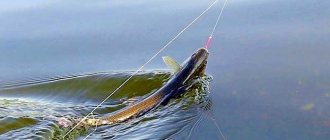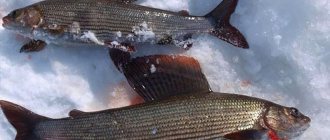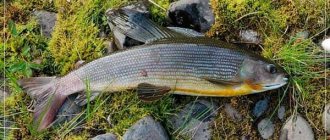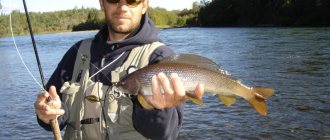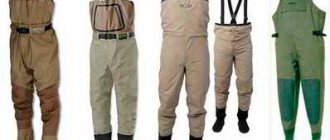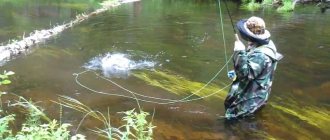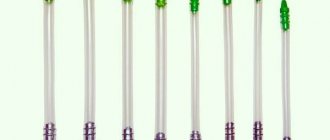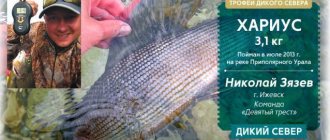Grayling, a close relative of salmon and whitefish, lives only in the Northern Hemisphere. Its habitat is the clean and cold waters of rivers and lakes with a rocky bottom. In Karelia, grayling is found in almost all rivers and in the cleanest and rockiest areas of Lake Onega. Grayling differs from other fish species by its large dorsal fin decorated with spots or stripes. Grayling also has a small adipose fin on its back, indicating the nobility of this fish and its connection with salmonids. Graylings can reach a weight of 2.0 – 2.5 kg. Typically, catches are dominated by individuals weighing 300–600 grams, but specimens weighing 800–1000 grams are not uncommon. The food supply of grayling includes crustaceans, mollusks, larvae, mayflies, caddis flies, as well as various insects that accidentally fall into the water. Although the grayling's main food supply is insects, crustaceans and mollusks, it will not refuse caviar and small fish. Grayling leads a sedentary lifestyle, but with the onset of consistently hot weather, when the water warms up very much. At this time, he leaves his homes for colder water or deeper water. In Lake Onega, grayling should be looked for on rocky shallows with depths of no more than 1-3 m, as well as in the surf with a rocky shore, where it is attracted by the abundance of crustaceans, caddis flies and various insects washed out from under the stones.
Fishing for grayling using a spinning rod
Spinning rod for grayling fishing should have a test of 0-5g. (ultra light), everyone chooses the length of the spinning rod themselves. A non-energy reel with a wound fishing line with a diameter of 0.2 - 0.25 mm is installed on the rod. As bait you need to have a whole arsenal of spinners and small wobblers. To catch grayling, you can use “Mepps” spinners with numbers from 0 to 3, petal colors: black, black with orange dots, silver, copper. Having a fly on the tee is not necessary, but sometimes it helps to catch a neighbor. You can also use wobblers from 1 to 3 cm long with natural colors.
Tackle for grayling - what is used to catch grayling
Most often, to catch grayling, anglers use bait that can be found at the fishing site. In addition to the red dung worm and grasshopper, grayling readily bites on other baits.
An excellent bait is a dragonfly larva, as well as caddis and jigs.
There are a lot of jigs at the bottom; they can be caught with a fine mesh net. Siberian fishermen use mormysh both as bait and for bait.
Caddisfly is one of the best summer baits. The larva lives in clean running water, close to the shore. Therefore, in some reservoirs, grayling is readily caught using this larva.
In muddy water, grayling is caught with a fishing rod with a five-meter telescope, a small hook and a line of 0.15-0.25 mm. The bait is a worm or caddis.
In rivers with a small current they fish with a fishing line with a float, in a fast current - with a donkey. The largest graylings are caught on fry.
Artificial flies can be used as bait.
On the Far Eastern rivers, grayling can be caught using float gear with bait, and spinning fishing is also known among anglers.
It is best to use small light-colored spoons that imitate fish.
In winter, in places with strong currents, soft spinning baits with jig heads are used for ice fishing.
Fly fishing for grayling in Karelia
Fly fishing was not originally intended for catching fish in calm water, but with the right selection of rods and cord, this is also possible on Lake Onega. For fly fishing for grayling in Karelia on Lake Onega, you will need a class 7 rod, reel and line, and a leader of 0.14. Also, it is necessary to remember that in case of strong excitement this method will not work. Each weather has its own fly colors and therefore everything is selected empirically. It’s not uncommon to catch bream and perch using fly fishing on Onega.
Characteristic
European grayling grows in length by a maximum of 60 centimeters, and its maximum weight does not exceed 6.7 kilograms. This fish differs from other species in having larger scales and the presence of a large and strongly pronounced dorsal fin. It consists of 5 to 7 soft and 12 to 17 hard rays. When unfolded, its shape resembles a sail, and when folded, it almost reaches the fish’s tail. The anal fin consists of 9 soft rays and 3 hard ones.
The dorsal fin is gray in color with dark round dots arranged in parallel rows. The pectoral fins are also gray.
The scales on the back have a greenish tint; on the sides they turn into a silvery surface. The abdominal area is silvery-white. Young animals have oval spots on the sides, which over time merge with the main body color.
The elongated shape of the body allows the fish to easily swim not only with the current, but also against it.
The diet consists of larvae, crustaceans, mollusks, insects, spiders, eggs and small fish.
Catching grayling with spinning or fly fishing
The method of catching grayling with a spinning rod using a light fly is quite possible. To do this, you need a spinning rod with a large dough of 10-30 g. and accordingly, you should use braid with a diameter of 0.15 or fishing line, but with a larger dough. Naturally, it is almost impossible to cast a light fly, and even with a thick thread. To do this, you need to equip the tackle with a liquid float or sbirulino with a special leash. By filling the float with water, you can easily adjust the depth of the fly when retrieving it or even make it play on the surface of the water, and its weight will help you cast the bait over a decent distance.
In summer, grayling, as a rule, does not lack food. Therefore, it can be very difficult to seduce him into artificial bait. The success of fishing largely depends on the correct selection of flies in size and color. The best information on this matter can be obtained by opening the stomach of a caught grayling and finding out which insects the fish currently prefers. In certain periods, even large individuals can feed exclusively on small midges, ignoring other insects. Grayling is most often caught using flies with bellies in brown, red, dark gray and olive tones. Grayling is especially partial to the red color, so it’s better to start fishing with a red fly.
If the grayling does not pay enough attention to your fly and is reluctant to take it, you can try changing the tackle and catching it with a spoon or fishing rod.
The bite on these baits is better in late summer and autumn. The grayling has its own grip on the spoon; having swallowed the bait, it begins to rush from side to side, and when a few meters remain from the boat, it rises to the top and begins to dance along the surface. When fishing for grayling, it is necessary to have a landing net, because Grayling has extremely weak lips and therefore it should be fished out carefully, without forcing it, and at the boat it should be carefully brought into the landing net. How to get there Prices Contacts
Karelia, his majesty lake grayling in July-August
The royal fish, I’ll tell you, it’s not even a matter of taste, but probably still a matter of appearance, slender, noble and graceful. A beautiful “aristocrat” fish that commands respect at first sight, a worthy fighter and rival.
It was grayling that became one of the main fish in the catches of our annual fishing trips to circumpolar Karelia.
Karelia itself is a separate romance that lasts a lifetime.
Having been there once, you always want to return and again feel yourself outside the bustle of the city and eternal problems, in the company of friends, when there is practically not a soul around and only occasionally boats or heroic kayakers are seen who risked going on a hike in their “fragile” boats in these harsh and changeable places.
The lake is huge, more than 50 km long, in places up to 30 km wide with depths up to 60 meters. Grayling is dispersed throughout almost the entire coastal strip, with the exception of “black spots” - lowlands with marshy areas of soil.
From time to time, when fishing from the shore or under the shore, Grayling is found everywhere, but as a rule it is rare and small, but I set myself the task of finding places where it goes out to feed.
Grayling prefers places with clearly defined characteristics:
- sleeves between coastal islands located near the mainland with a depth of 1-3 meters with a rocky bottom in the form of placers of boulders of impressive size bordering a stone plateau and proximity to deep water with significant depths.
Such a relief is often found in long-lasting backwaters, this is not our option, since such an island in this case is an elevation of the mainland, but we need the proximity of large water. Grayling, of course, is present there too, but in smaller quantities and mostly small. And it’s more likely not only a matter of relief, but also the temperature stratification of water between open areas and those protected from the wind rose.
- Sand spits (continuation of the islands) with individual boulders and stumps from trees that were cut down and then happily flooded during the time of the socialist idea of creating giant reservoirs.
It was in such places, year after year, that I found large grayling, which seemed so stuck to these places that only as a result of a general decrease in biting due to weather conditions and pressure surges, it stopped making itself known.
The best biting time is in the period July-August from 5 o'clock in the morning and lasts until about 11 o'clock, in the evening, from 16 to dark, while the grayling itself may not show itself in any way, but the bite will be excellent.
In the morning and evening hours until darkness, you can watch small grayling splashing, which is usually a signal to launch the boat and go to “their” places for large specimens.
Although this rule is not an axiom, so even in this case, there is a risk that the bite will be zero.
Fishing from the shore is less successful, since it seems difficult to throw a bait weighing 2-8g. to the right place, from my observations I concluded that grayling are sort of ranked by distance to the shore and the large ones always stay at a decent distance from the shore. Exceptions are places between closely located islands, however, even in this case it is not always possible to place the bait at the required range.
In addition, fishing from a boat makes it possible to diversify fishing methods and at the same time avoid snags, which of course has a positive effect on the result and the safety of the arsenal of baits.
It should also be noted that with moderate and strong winds, grayling activity increases due to midges, insects and mayflies blown out of forests, which circle in the coastal zone above the water and provide excellent and plentiful food for grayling of all sizes.
On such days, you should choose a place protected from the wind, that is, opposite to its direction.
Complete calm, on the contrary, does not contribute to the bite and on such days there is every chance of being left without a catch.
Of course, finding grayling is half the battle; now we are faced with the task of catching it! We will talk about this in the second part of the article, where we will look at gear, bait, fishing techniques and tactics.
In the meantime, let’s touch on the most interesting species of fish, which, in addition to grayling, arouse the interest of the spinning angler who decides to go fishing in this blessed and beautiful region:
Her Majesty brown trout, a beautiful fish, cannot be said to be in abundance, but quite a decent herd, is caught mainly by trolling or by splashing on rare windless days. In other cases it is an accidental bycatch.
What is the value
Evidence that the European grayling is a relative of salmon fish is not only the adipose fin located on the back, but also the most delicate white-pink meat, distinguished by excellent taste characteristics. It contains only water, proteins and fats, and does not contain carbohydrates at all.
Grayling meat is a nutritious product with low calorie content. It also does not cause an allergic reaction. The fish has a barely noticeable layer of fat and contains very few bones. Grayling dishes can often be found on the menus of many restaurants, since it does not emit the unpleasant smell of mud. Chefs prepare a huge variety of dishes from its meat. Thanks to its mild aroma and delicate taste, it goes perfectly with various types of spices, vegetables, fruits and cereals. Grayling is stewed, fried, smoked and salted.
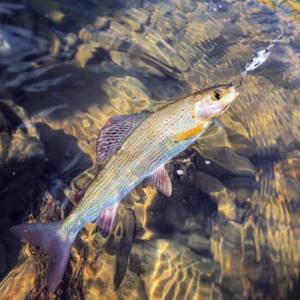
Fishing and habitat areas
Grayling lives exclusively in fast-flowing cold rivers and lakes. It prefers areas of reservoirs with rocky and pebble bottoms. Fish cannot live in polluted and muddy water. In the southern regions, the habitat of grayling is foothill and mountain rivers and streams. In northern and eastern Siberia it can be found in almost all bodies of water, if the water in them is not polluted.
It does not live in places with dense vegetation or in narrow bays with a sandy bottom. European grayling feels very comfortable on the surf shores, because there is always a lot of food there.
Juveniles live in shallow areas and on riffles. Large fish live in deeper areas, which reduces the risk of becoming prey to trout or salmon. The favorite areas of grayling on fast-flowing rivers are places located below and above rapids and rifts.
In autumn, fish move from small rivers to large rivers and lakes. For the winter, it goes to the seas or remains in large rivers, looking for areas with holes.
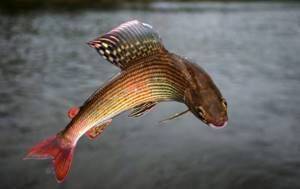
Grayling leads a sedentary lifestyle. During the summer they are constantly in the same place. They leave it only in the evening, moving to rapids or riffles, where they hunt for insects falling on the water surface.
During the day, the fish stay in deeper areas, behind rocks and in the grass. In rare cases, it approaches a shallow shore where there is no vegetation and a strong current.
Although grayling lives in schools, for hunting the fish are distributed along the bottom of the reservoir so that each individual has a hunting area with a diameter of approximately 2 meters.
